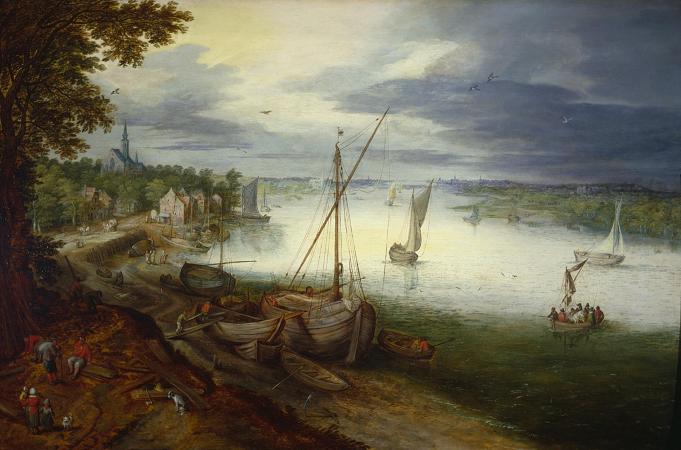River Scheldt. The Scheldt is a 350-kilometre long river in northern France, western Belgium, and the southwestern part of the Netherlands. Its name is derived from an adjective corresponding to Old English sceald, Modern English shoal, Low German schol, West Frisian skol, and Swedish skäll. The headwaters of the Scheldt are in Gouy, in the Aisne department of northern France. It flows north through Cambrai and Valenciennes, and enters Belgium near Tournai. In Ghent, where it receives the Lys, one of its main tributaries, the Scheldt turns east. Near Antwerp, the largest city on its banks, the Scheldt flows west into the Netherlands towards the North Sea. Originally there were two branches from that point: the Oosterschelde; and the Westerschelde. In the 19th century, however, the river was cut off from its eastern branch by a dyke that connects Zuid-Beveland with the mainland. Today the river therefore continues into the Westerschelde estuary only, passing Terneuzen to reach the North Sea between Breskens in Zeelandic Flanders and Vlissingen on Walcheren. The Scheldt is an important waterway, and has been made navigable from its mouth up to Cambrai. Above Cambrai, the Canal de Saint-Quentin follows its course. The port of Antwerp, the second largest in Europe, lies on its banks. Several canals connect the Scheldt with the basins of the Rhine, Meuse and Seine, and with the industrial areas around Brussels, Liège, Lille, Dunkirk, and Mons. The Scheldt flows through the following departments of France, provinces of Belgium, provinces of the Netherlands, and towns: Aisne: Gouy. Nord: Cambrai, Denain, Valenciennes. Hainaut: Tournai. West Flanders: Avelgem. East Flanders: Oudenaarde, Ghent, Dendermonde, Temse. Antwerp: Antwerp. Zeeland: Hulst, Terneuzen, Sluis, Vlissingen. The Scheldt estuary has always had considerable commercial and strategic importance. In Roman times, it was important for the shipping lanes to Roman Britain. Nehalennia was venerated at its mouth. The Franks took control over the region about the year 260 and at first interfered with the Roman supply routes as pirates. Later they became allies of the Romans. With the various divisions of the Frankish Empire in the 9th century, the Scheldt eventually became the border between the Western and Eastern parts of the Empire, which later became France and the Holy Roman Empire. This status quo remained intact, at least on paper, until 1528, but by then, both the County of Flanders on the western bank and Zeeland and the Duchy of Brabant on the east were part of the Habsburg possessions of the Seventeen Provinces. Antwerp was the most prominent harbour in Western Europe. After this city fell back under Spanish control in 1585, the Dutch Republic took control of Zeelandic Flanders, a strip of land on the left bank, and closed the Scheldt for shipping. That shifted the trade to the ports of Amsterdam and Middelburg and seriously crippled Antwerp, an important and traumatic element in the history of relations between the Netherlands and what was to become Belgium. Access to the river was the subject of the brief Kettle War of 1784, and during the French Revolution shortly afterwards, the river was reopened in 1792. Once Belgium had claimed its independence from the Netherlands in 1830, the treaty of the Scheldt determined that the river should remain accessible to ships heading for Belgian ports. Nevertheless, the Dutch government would demand a toll from passing vessels until 16 July 1863. The Question of the Scheldt, a study providing a history of the international legal arrangements governing the Western Scheldt, was prepared for the use of British negotiators at the Treaty of Versailles in 1919. In the Second World War, the Scheldt estuary once again became a contested area. Despite Allied control of Antwerp, German forces still occupied fortified positions in September 1944 throughout the Scheldt estuary west and north, preventing any Allied shipping from reaching the port. In the Battle of the Scheldt, the Canadian First Army successfully cleared the area, allowing supply convoys direct access to the port of Antwerp by November 1944.
more...







